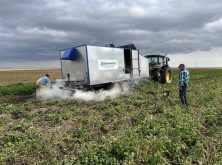Last year, it was very dry over much of the Prairies. Your lower-than-expected yields have got you calculating how much nutrients/fertilizer are left in your grain or oilseed fields. Also to consider is how much herbicide residue is left in some of your fields. What crops do you intend seeding this spring? Canola, perhaps, due to the tempting bushel price?
Herbicides perform well under moist growing seasons and normal temperatures. Unfortunately, 2021 was an unusual season and in order to break down herbicides moist soil and normal temperatures are needed. Dry or very dry soils in the growing season stop the breakdown process. Little or no herbicide breakdown occurs during the winter if it’s too cold.
In a normal year, a particular herbicide may behave very well. In very dry years followed by our normal cold, frozen winters, the herbicide may not have broken down very much. By spring of the next year, as the soil warms up, last year’s herbicide may be present ready to do its weed control job.
Read Also

Claas brings 1000 Series SP forage harvesters to Canada
In mid-August, Claas unveiled its new line of Jaguar forage harvesters at an event in Visalia, California, deep in the heart of that state’s dairy region.
Unfortunately, if, for example, you plant canola into such a soil, with residual Group 2s, the herbicide will do its job — eliminating or significantly damaging your seeded canola crop.
Imazamox or imazethapyr are examples of such herbicides, particularly if your soil is on the acid side, that is, below a 6.5 pH. The lower the pH the drier the soil, the slower these herbicides break down.
Yes, you can still plant canola if you have used this Group 2 herbicide in 2021. Plant a clubroot-resistant Clearfield canola variety that is tolerant to Group 2 herbicides, which may be present in your cropland. Another herbicide, such as flucarbazone, may have been used in 2021 and your cropland experienced severe drought last year. The label on this product cautions you not to plant canola the following year if your cropland is in the brown soil zone. As a consequence of the 2021 drought, I would recommend that you skip canola this year and stick with wheat or consider a Clearfield canola.
Several other Group 2 herbicides could carry over and cause some crop damage, but if we have a normal season with good to reasonable rainfall, many of these seedling-damaged crops could recover and grow normally if the herbicide carryover was modest.
In the event of a mistake, and you see considerable damage and seedling loss in a canola crop, you should reseed immediately to wheat, barley or oats.
Herbicide damage and litigation
Damage to your crops can occur from herbicide residues, herbicide drift, herbicide misinformation, if recorded, or, even, herbicide failure to perform for a number of reasons.
If you intend litigation with respect to any herbicide or pesticide problem, for that matter, you must be well prepared if you intend to follow the legal route. Even if you do not opt for a legal approach and wish to negotiate with your neighbour about a herbicide drift problem, there are a number of considerations:
- Keep records with a camera or cameras, an assistant or witness, lots of photographs, a GPS recorder and a notebook with dates and weather conditions; for example, “We had frost 10 days ago.” Or, “No rain since seeding.”
- Ask a local expert to help, if available, and consider the time and effort you will need to quantify the herbicide damage.
- Know your field history for the past three years, past crop yields, fertility inputs, date of herbicide application, the date herbicide damage was first noted and the field area of herbicide damage. Also, check for spray drift pat- terns.
- Consider your spray tank cleanout. Did you read the herbicide label properly? Did you use a clean source of water? Did the herbicide you purchased freeze in storage and lose its efficacy? Could you be responsible for the damage?
- Patchy damage could be due to different soil types affecting the residual damage pattern. Does the damage get worse with time, for example, seven days later, or are the damaged seedlings recovering? Describe the damage and include photographs, preferably with a witness present.
- With seedling issues, especially canola, you could be looking at fungal seedling diseases despite a fungicide seed treatment. Fertilizer injury, especially phosphate injury, could result in consider- able seedling loss, which depends upon how the fertilizer seed placement was done.
- Do not jump to any instant conclusions. Describe what you see and be prepared to take responsibility for the issue. If you are satisfied that damage was done to your crop, draw up an estimation of the damaged crop area, for example, 50 per cent of your specific crop, or, perhaps, 10 per cent of the crop and at the end of the season, if possible, your financial crop loss estimate.
- Beware the farmer who has a reputation of blaming his crop losses on spray drift problems from his neighbours’ herbicide applications. This blame-and-sue neighbour may engage a lawyer and it is likely this neighbour has done this to several other growers with adjacent cropland. Find out if there are other farmers in the same boat as you. This litigation tactic has been employed a few times by organic growers with impending crop failures. Get together with those farmers who are faced with litigation. Take your time, seek advice, consider costs and take logical steps to clear up this inconvenience.
















